May 1 - 31, 2025: Issue 642
Neville Cayley Calls Just Two Yellow-Tailed Black Cockatoos Visit PON Yard
Neville Cayley, grandson of 'Birdman of Avalon Beach' Neville William Cayley and author of 'What Bird is That?', and great-grandson of Neville Henry Peniston Cayley 'Birdman of Mosman and Cronulla', will return to Sydney this coming Spring for a 'catch-up' and to share some more information on his family.
Neville helped provide that note of 'continuity' most PON history pages close on, and it was the news services pleasure to host a visit back in 2012 to his grandfather's former home and studio on North Avalon Beach headland - called 'Ideal View' - and on private property.
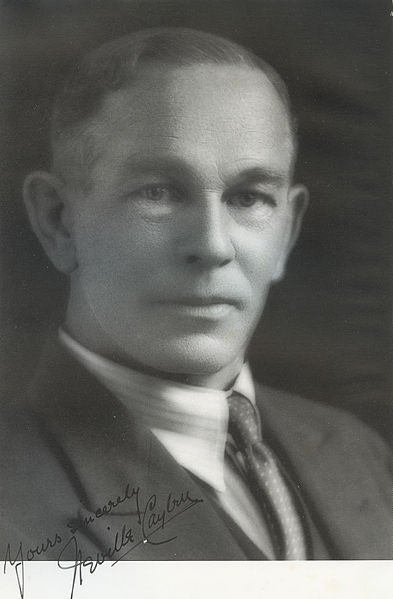
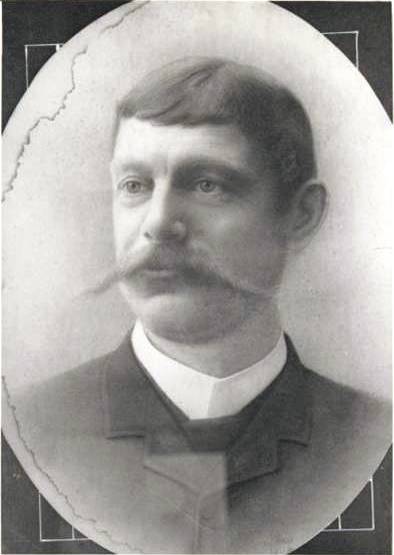
Neville William Cayley Neville Henry Peniston Cayley
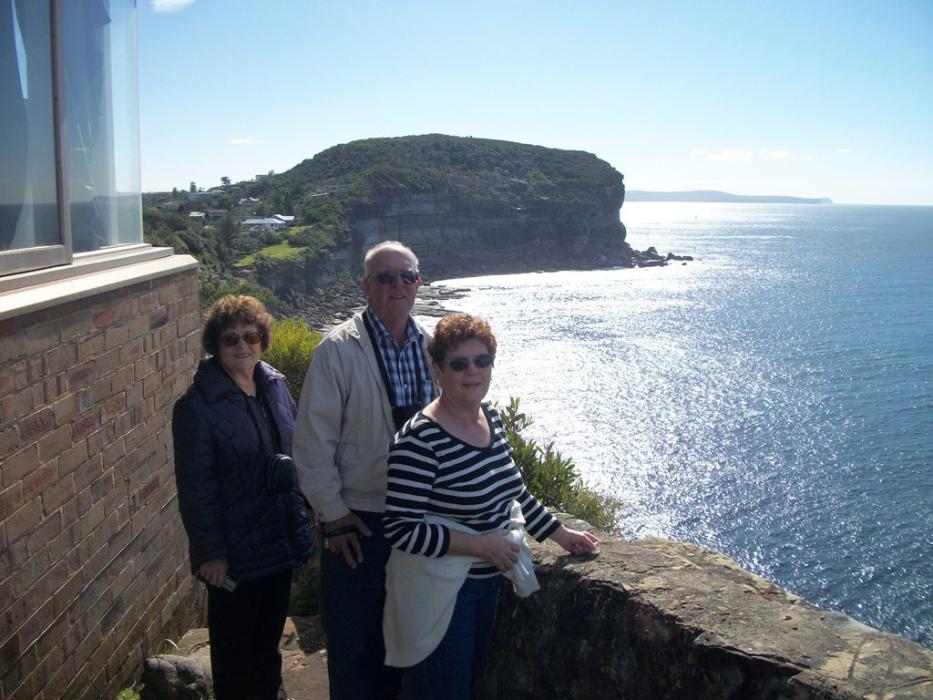
Neville David Cayley, sister Joan and wife Vera at 'Ideal View' , Marine Parade, Avalon, May 2012. Pic: AJG/PON
Fortuitously, a pair of Yellow-tailed black cockatoos (Zanda funerea) landed in the Pittwater Spotted Gums (Eucalyptus (Corymbia) maculata) of the PON front yard, currently flowering, while talking on Wednesday May 14 - possibly part of the same flock seen winging their way to Bangalley headland early in the morning the week before.
Pittwater's spotted gums - currently flowering
Neville quickly rang off so some photos could be taken and sent to him. Although a bit too excited to get to see them up close to get good photos, and in our very own yard, a few pictures were promptly taken and sent north to Bundaberg where Neville lives and once farmed - he's now retired, at 80 years young.
Kevin Murray and Joe Mills got some better photos while walking the Elvina Bay- Lovett Bay loop a few years ago, feasting on one of their favourites, Banksias.
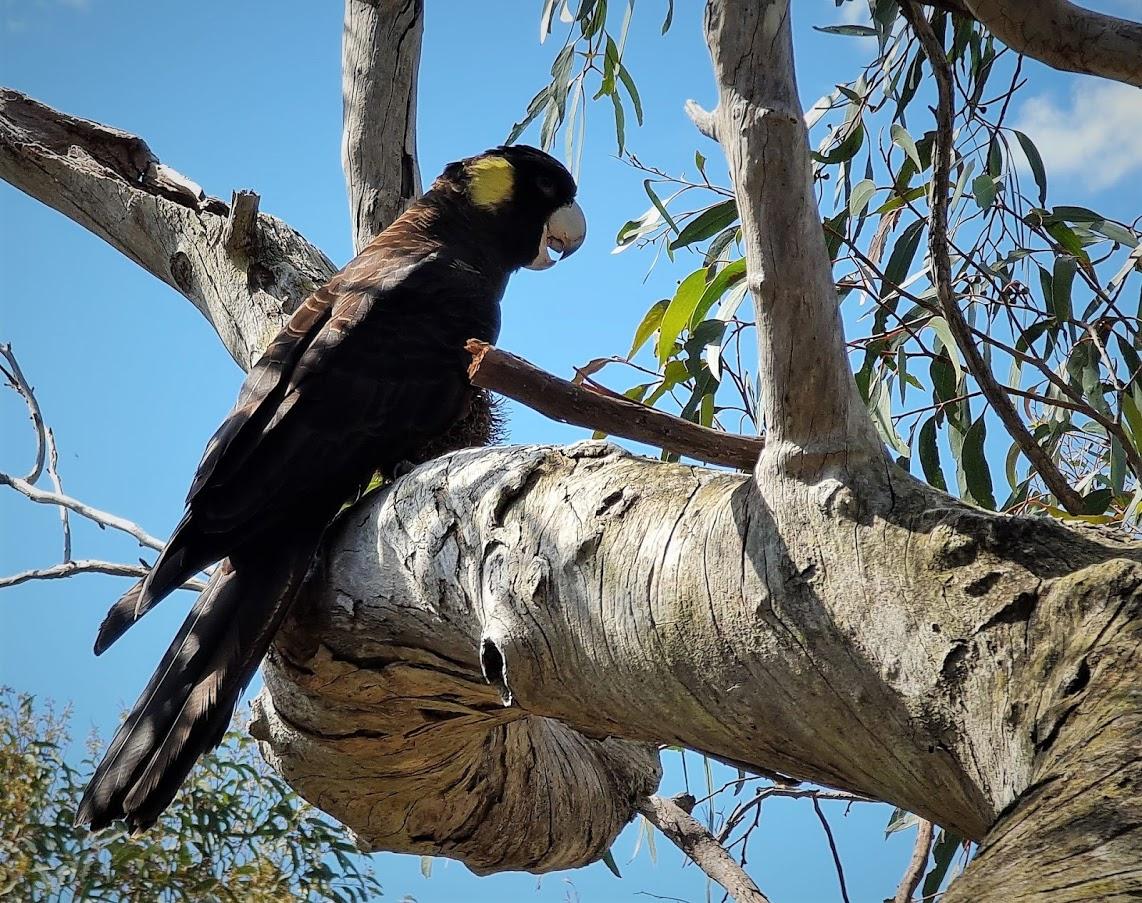
Yellow-tailed black cockatoo, Calyptorhynchus funereus, above Lovett Bay, October 2020 - photo by Joe Mills
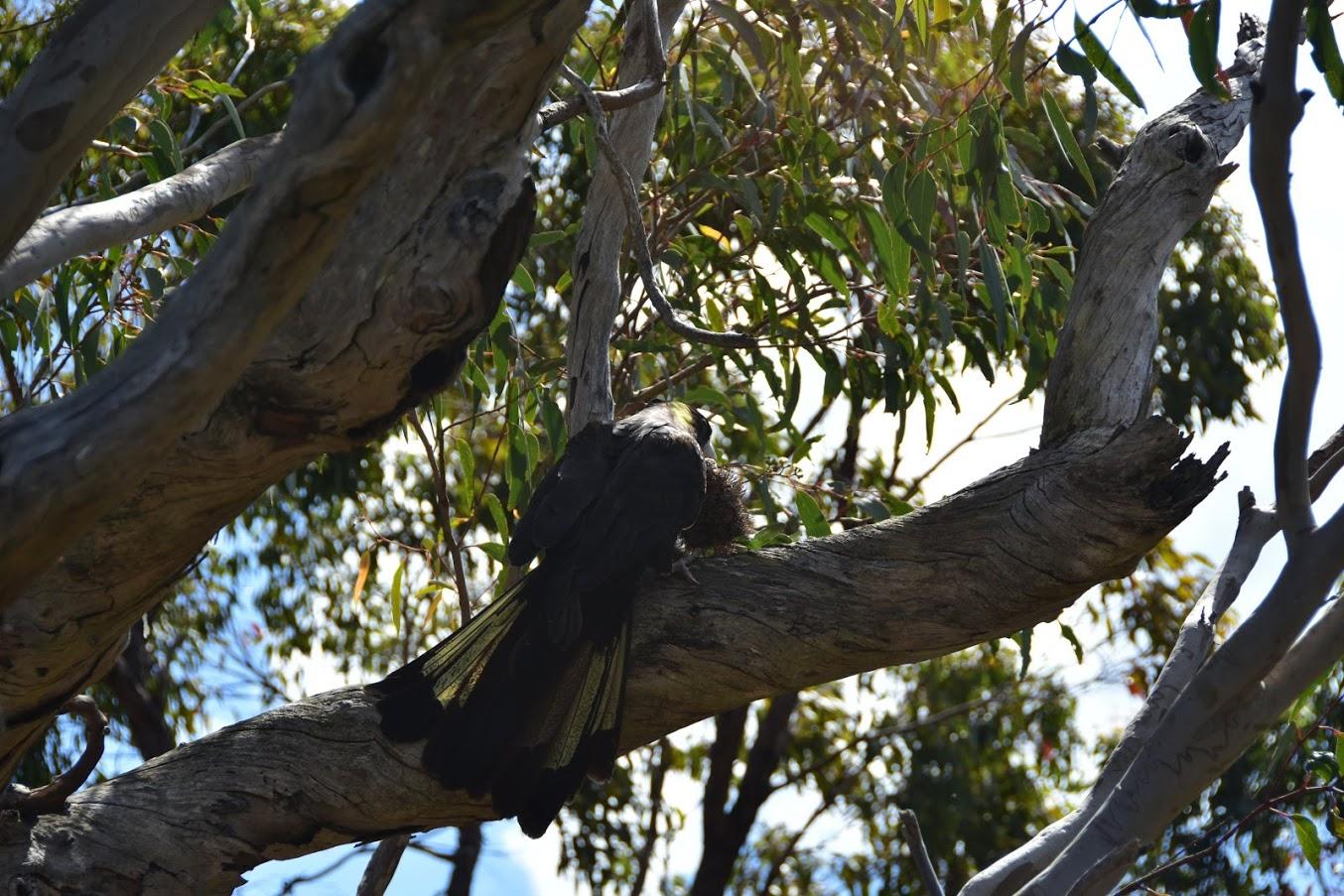
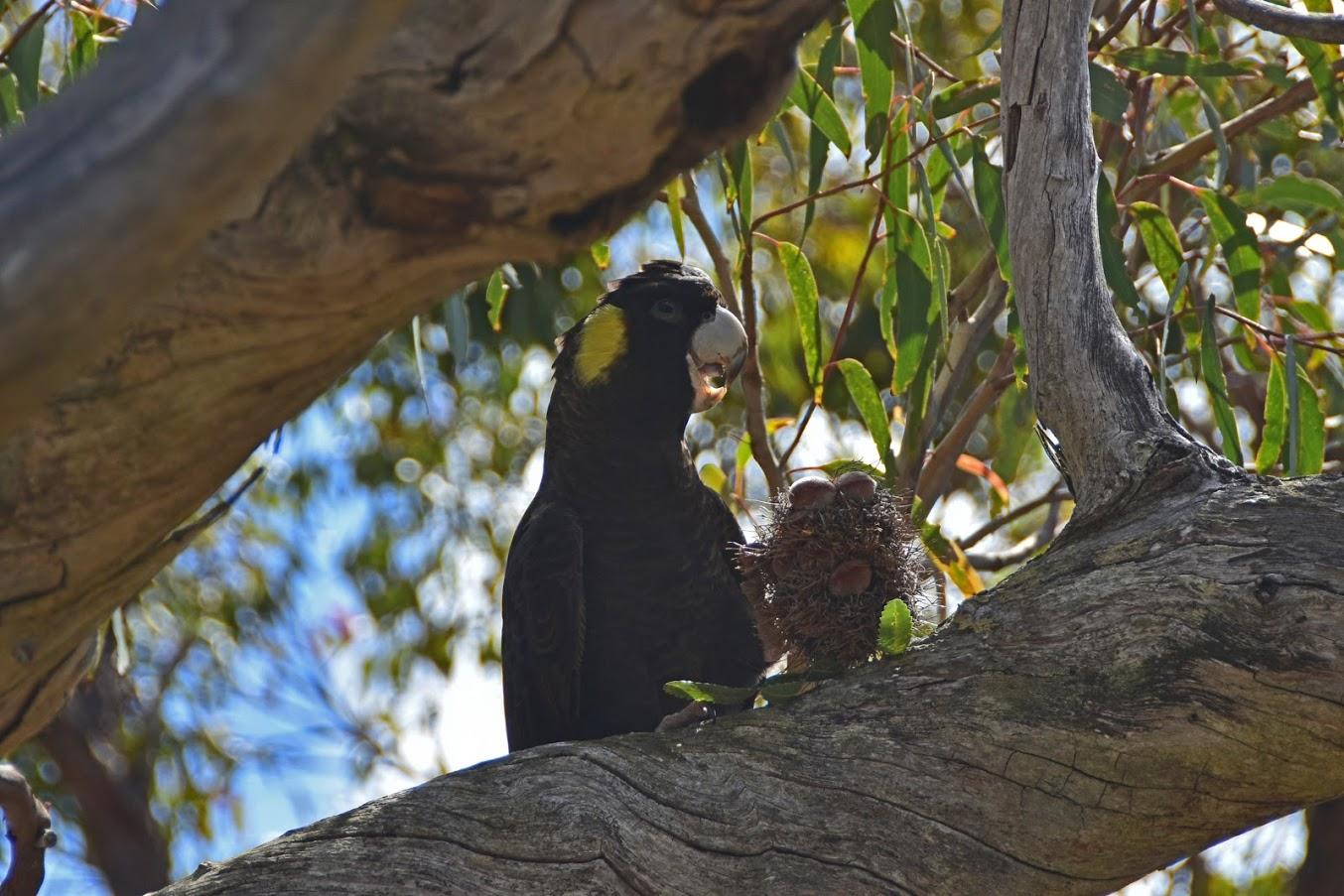
Yellow-tailed black cockatoo, Calyptorhynchus funereus, above Lovett Bay, October 2020 - photos by Kevin Murray
The yellow-tailed black cockatoo is one of two species of black cockatoos that visit Pittwater for the food trees here. A few years back Paul Wheeler shared some photos of regular visitors to his Clareville home for feasting on she oak seeds, the Glossy Black-cockatoo (Calyptohynchus lathami).
Glossy Black-cockatoo, Calyptohynchus lathami - photos by Paul Wheeler
The yellow-tailed black cockatoo (Zanda funerea) is a large cockatoo native to the south-east of Australia measuring 55–65 cm (22–26 in) in length. It has a short crest on the top of its head. Its plumage is mostly brownish black and it has prominent yellow cheek patches and a yellow tail band. The body feathers are edged with yellow giving a scalloped appearance. The adult male has a black beak and pinkish-red eye-rings, and the female has a bone-coloured beak and grey eye-rings.
In flight, yellow-tailed black cockatoos flap deeply and slowly, with a peculiar heavy fluid motion. Their loud, wailing calls carry for long distances. The yellow-tailed black cockatoo is found in temperate forests and forested areas across south and central eastern Queensland right through to south-eastern South Australia, including a very small population persisting in the Eyre Peninsula.
Two subspecies are recognised, although Tasmanian and southern mainland populations of the southern subspecies xanthanotus may be distinct enough from each other to bring the total to three. Birds of subspecies funereus (Queensland to eastern Victoria) have longer wings and tails and darker plumage overall, while those of xanthanotus (western Victoria, South Australia and Tasmania) have more prominent scalloping. The subspecies whiteae is found south of Victoria to the East of South Australia and is smaller in size.
They nest in large hollows high in old growth native trees (~ greater than 200 years old), usually Eucalyptus regnans. Although they remain common throughout much of their range, fragmentation of habitat and loss of large trees suitable for nesting has caused population declines in Victoria and South Australia. Furthermore, the species may lose most of its mainland range due to climate change. In some places yellow-tailed black cockatoos appear to have partially adapted to recent human alteration of landscape and they can often be seen in parts of urban Canberra, Sydney, Adelaide and Melbourne.
Yellow-tailed black cockatoos are diurnal, raucous and noisy, and are often heard before being seen. They make long journeys by flying at a considerable height while calling to each other, and they are often seen flying high overhead in pairs, or trios comprising a pair and their young, or small groups. Outside of the breeding season in autumn or winter they may coalesce into flocks of a hundred birds or more, while family interactions between pairs or trios are maintained. They are generally wary birds, although they can be less shy in urban and suburban areas. They generally keep to trees, only coming to ground level to inspect fallen pine or Banksia cones or to drink. Flight is fluid and has been described as "lazy", with deep, slow wingbeats.
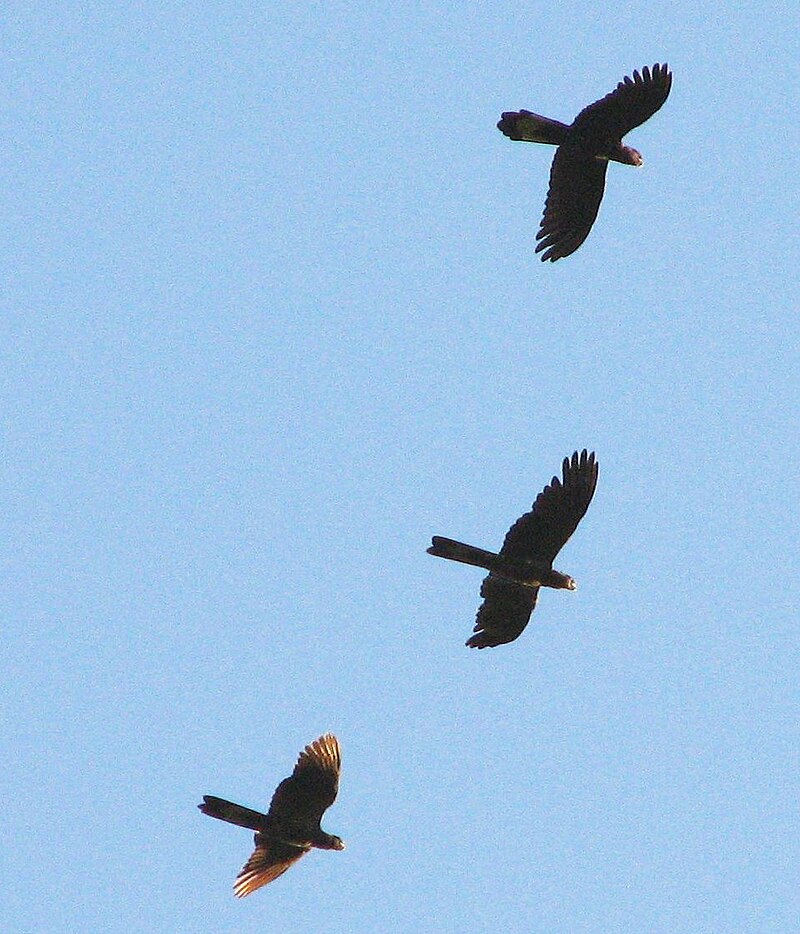
A family flying overhead in Tasmania. Photo: Peter Shanks
The breeding season varies, taking place from April to July in Queensland, January to May in northern New South Wales, December to February in southern New South Wales, and October to February in Victoria, South Australia and Tasmania. The male yellow-tailed black cockatoo courts by puffing up his crest and spreading his tail feathers to display his yellow plumage. Softly growling, he approaches the female and bows to her three or four times. His eye ring may also flush a deeper pink. Nesting takes place in large vertical tree hollows of tall trees, generally eucalypts.
Like other cockatoos, this species is long-lived. A pair of yellow-tailed black cockatoos at Rotterdam Zoo stopped breeding when they were 41 and 37 years of age, but still showed signs of close bonding.
The yellow-tailed black cockatoo's diet primarily includes seeds of native and introduced plants. They also feed on wood-boring grubs.
The diet of the yellow-tailed black cockatoo is varied and available from a range of habitats within its distribution, which reduces their vulnerability to degradation or change in habitat. Much of the diet comprises seeds of native trees, particularly she-oaks (Allocasuarina and Casuarina, including A. torulosa and A. verticillata), but also Eucalyptus (including E. maculata flowers and E. nitida seeds), Acacia (including gum exudate and galls), Banksia (including the green seed pods and seeds of B. serrata, B. integrifolia, and B. marginata), and Hakea species (including H. gibbosa, H. rugosa, H. nodosa, H. sericea, H. cycloptera, and H. dactyloides).
Wy-la was an aboriginal term from the Hunter Region of New South Wales for this beautiful, while the Dharawal name from the Illawarra region is Ngaoaraa.
Information: BirdLife Australia and BirdLife International.
Pat Connors Avian Grant for Glossy Black-cockatoo
May 12, 2025
WIRES are proud to share that Glossy Black Conservancy Inc. has been awarded the 2024 Pat Connors Avian Grant for their critical project: Habitat mapping for the vulnerable Glossy Black-Cockatoo in Southeast Queensland.
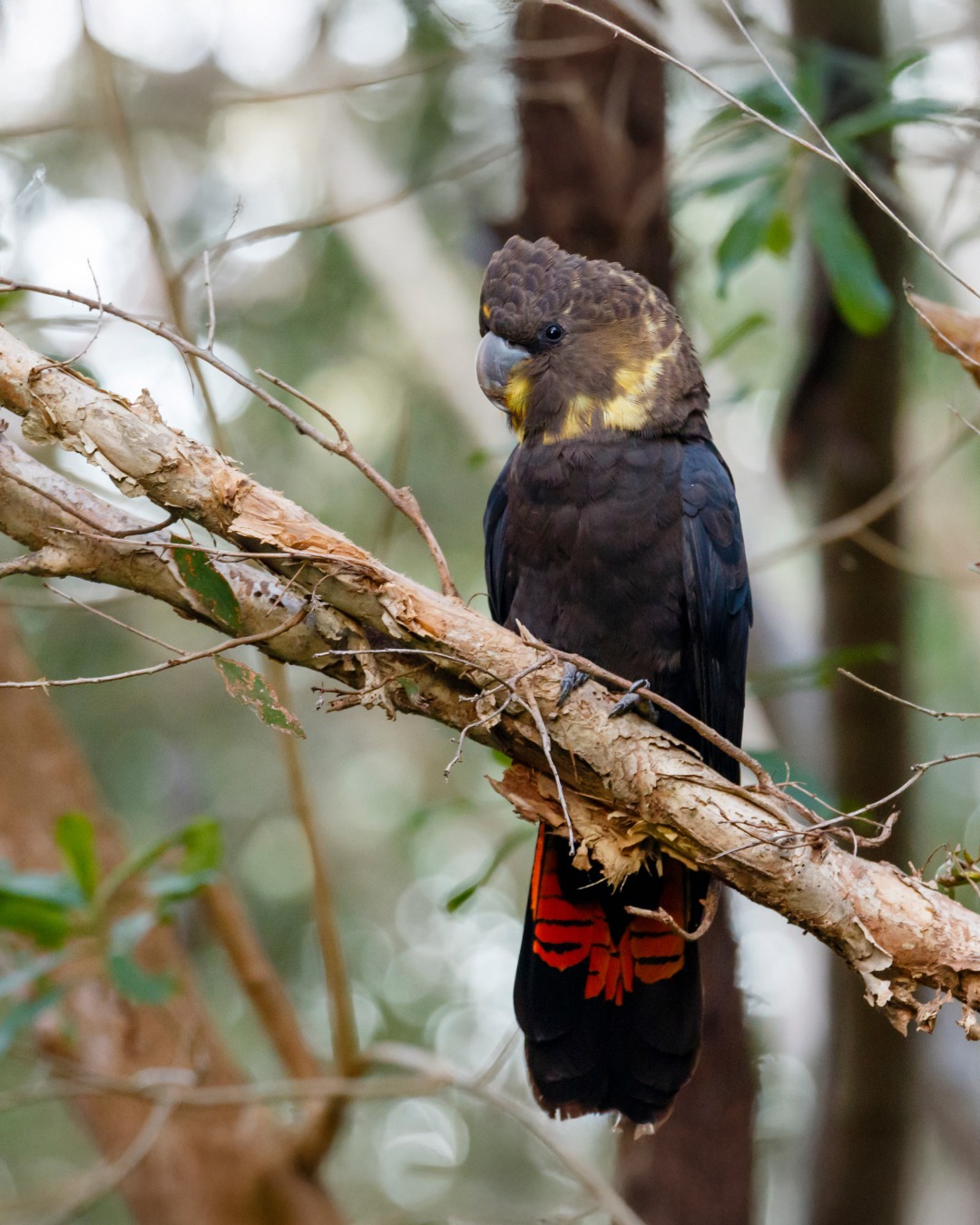
Photo: WIRES/Glossy Black Conservancy Inc
This unique bird relies on specific habitats that are fast disappearing in one of Australia’s most rapidly developing regions. The most recent habitat data is from 2016, before the devastating 2019 bushfires, and planning decisions are still being made using that outdated information. This project will change that.
With support from this grant, experts will update essential habitat maps, ensuring data meets standards set by the Queensland Vegetation Management Act. The project will also empower councils and conservationists with webinars to share methodologies and incorporate the latest findings into local planning, maximising protection for this vulnerable species.
Project - Habitat mapping for the vulnerable Glossy Black-Cockatoo in Southeast Queensland
Use of the grant: The Glossy Black Conservancy is an independent conservation and research organisation providing resources, training and support to people and groups so that they can identify, collect data and take action to protect the nationally vulnerable Glossy Black-Cockatoo and its habitat. Southeast Queensland is the fastest growing region in Australia and holds critical stands of habitat for the nationally-listed Glossy Black-Cockatoo. Habitat mapping for this species, which has been severely impacted by 2019 bushfires, was last undertaken in 2016. Researchers, Councils and State Government are making planning and policy decisions about the species, using data that is woefully out-of-date. The grant will be used to update habitat mapping for the nationally-listed Glossy Black-Cockatoo in Southeast Queensland - one of Australia’s regions at greatest risk of habitat clearing.
We will engage an ecologist to gather data from known sources as well as a GIS specialist with skills in creating habitat mapping to drive conservation outcomes. Together, these specialists will work with the Conservancy’s Science & Research committee to update Taxon Profiles and ensure mapping is to a standard that will inform Essential Habitat as defined by the Queensland Vegetation Management Act (1999).
Once mapping is complete, we’ll two webinars focused on sharing mapping methodology and Taxon Profiles so the project can be replicated across the country. And a third that will focus on Councils of SEQ to share mapping methodology and drive incorporation of new mapping data into local planning instruments, to maximise habitat protection.
Pat Connors Avian Grant
To be awarded for one large avian project or a series of smaller avian projects.
Patrick Connors was a long-term member of WIRES. He developed WIRES first rescue and rehabilitation database and call recording system pro-bono and supported it for well over a decade. Pat's contribution enabled WIRES to provide rescue advice and assistance for 2 million animals. Pat passed away in December 2020 and this grant honours his outstanding contribution to WIRES, and his passion for birds.
In 2024 there were 68 successful projects in 4 tiers across Australia.
WIRES 2025 Grants Applications Open May 19
WIRES National Grants Program
National Support for Critical Wildlife Projects
WIRES’ National Grants Program (NGP) is designed to support best practice wildlife rescue and rehabilitation, an increase in emergency preparedness for wildlife, and native species recovery projects, to improve long-term outcomes in Australia.
Program Objectives
- The NGP was developed to provide ongoing support for wildlife, and their habitats, across Australia. WIRES’ focus is on proposals that have tangible, positive, and ideally long-term, outcomes for wildlife. Program objectives include:
- Building capacity and capability for the Australian wildlife rescue and rehabilitation sector,
- Improving emergency preparedness and response capabilities to assist wildlife,
- Preserving species and their habitat through projects leading to long term positive outcomes for native wildlife,
- Raising community awareness and inspiring broader community involvement in supporting Australian wildlife rescue, rehabilitation and preservation.
Funding Categories
Up to $1 million is available across these tiers annually, and eligible applicants are invited to submit proposals for:
- Tier 1: Individually Licensed Wildlife Rescuers and Carers (maximum $2,000)
- Tier 2: Licensed Wildlife Rescue and Rehabilitation Organisations (maximum $8,000)
- Tier 3: Environmental NGOs and Community Groups (maximum $20,000)
- Tier 4: Consortia/Multi-partner Collaborations (maximum $50,000)
Application process
Key dates for 2025 applications:
Please note that due to limited funding and a competitive assessment process, not every application that meets the eligibility criteria may receive a WIRES Grant.
Applications open - 19th May 2025
Online webinar #1 - 12.30pm AEST 21st May - Register Here
Online webinar #2 - 7.30pm AEST 3rd June - Register Here
Applications close – 20th June (5pm AEST)
Successful applicants notified - September 2025
Grant announcements and unsuccessful applicants notified - October 2024
Reports due - Final for 6-month progress for – March 2026
Final Report due and project completed - 12-month month projects - September 2026.
How to Apply
Please note that due to limited funding and a competitive assessment process, not every application that meets the eligibility criteria may receive a WIRES Grant.
Click on APPLY NOW link when available to access the WIRES Grant Portal.
- Create account or log in. Please note that you will need to tick “Yes” to receiving notifications if you wish to be sent confirmation of application submission.
- Read information on the home page
- Click on “Start application”
- Select your State/Territory
- Select “WIRES National Grants Program 2025” and then the appropriate tier.
- If you wish to leave a partially completed application, make sure you press ‘Save + close’ and log out.
- You can log back in and continue to edit your application form until you are ready to submit.
- To submit your application, select the ‘Submit application’ button.
- Note, no changes can be made once this is selected.
You will receive a confirmation email when your application has been successfully received. If you do not receive an email, please ensure you check your junk mail and add us to your safe sender list.
Visit this page on May 19 when the apply now link becomes available to commence your application.